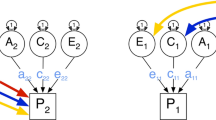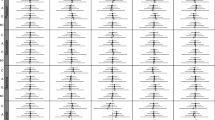Abstract
For many multivariate twin models, the numerical Type I error rates are lower than theoretically expected rates using a likelihood ratio test (LRT), which implies that the significance threshold for statistical hypothesis tests is more conservative than most twin researchers realize. This makes the numerical Type II error rates higher than theoretically expected. Furthermore, the discrepancy between the observed and expected error rates increases as more variables are included in the analysis and can have profound implications for hypothesis testing and statistical inference. In two simulation studies, we examine the Type I error rates for the Cholesky decomposition and Correlated Factors models. Both show markedly lower than nominal Type I error rates under the null hypothesis, a discrepancy that increases with the number of variables in the model. In addition, we observe slightly biased parameter estimates for the Cholesky decomposition and Correlated Factors models. By contrast, if the variance–covariance matrices for variance components are estimated directly (without constraints), the numerical Type I error rates are consistent with theoretical expectations and there is no bias in the parameter estimates regardless of the number of variables analyzed. We call this the direct symmetric approach. It appears that each model-implied boundary, whether explicit or implicit, increases the discrepancy between the numerical and theoretical Type I error rates by truncating the sampling distributions of the variance components and inducing bias in the parameters. The direct symmetric approach has several advantages over other multivariate twin models as it corrects the Type I error rate and parameter bias issues, is easy to implement in current software, and has fewer optimization problems. Implications for past and future research, and potential limitations associated with direct estimation of genetic and environmental covariance matrices are discussed.





Similar content being viewed by others
Notes
We repeated the second simulation study to examine whether the observed results were specific to the likelihood ratio test or whether they could generalize to other hypotheses testing techniques such as the Wald Test. The Wald test results were effectively equivalent with the LRT results above, making their presentation here unnecessary.
References
Boker SM, Neale MC, Maes HH, Wilde MJ, Spiegel M, Brick TR, Estabrook R, Bates TC, Mehta P, von Oertzen T, Gore RJ, Hunter MD, Hackett DC, Karch J, Brandmaier A, Pritikin JM, Zahery M, Kirkpatrick RM, Wang Y, Driver C, Johnson SG, Kraft D, Wilhelm S, Manjunath BG (2017) OpenMx 2.7.17-23 User Guide.
Bulik-Sullivan BK (2015) Relationship between LD score and haseman-Elston, bioRxiv. https://doi.org/10.1101/018283
Carey G (2005) Cholesky problems. Behav Genet 35(5):653–665
Coventry WL, Keller MC (2005) Estimating the extent of parameter bias in the classical twin design: a comparison of parameter estimates from extended twin-family and classical twin designs. Twin Res Hum Genet 8(3):214–223
Dominicus A, Skrondal A, Gjessing HK, Pedersen NL, Palmgren J (2006) Likelihood ratio tests in behavioral genetics: problems and solutions. Behav Genet 36(2):331–340
Falconer DS (1960) Introduction to quantitative genetics. Oliver and Boyd, London
Haldane JBS (1996) The negative heritability of neonatal jaundice. Ann Hum Genet 60:3–5
Martin NG, Eaves LJ (1977) The genetical analysis of covariance structure. Heredity 38(1):79–95
Neale MC, Cardon LR (1992) Methodology for genetic studies of twins and families. Kluwer Academic Publishers BV, Dordrecht
Neale MC, Fulker DW (1984) Heritability of item responses on the eysenck personality questionnaire. Personal Individ Differ 7:771–779
Neale MC, Røysamb E, Jacobson K (2006) Multivariate genetic analysis of sex limitation and G E interaction. Twin Res Hum Genet 9(4):481–489
Neale MC, Hunter MD, Pritikin JN, Zahery M, Brick TR, Kickpatrick RM, Estabrook R, Bates TC, Maes HH, Boker SM (2016) OpenMx 2.0: Extended structural equation and statistical modeling. Psychometrika 80(2):535–549. https://doi.org/10.1007/s11336-014-9435-8
Newman HH, Freeman FN, Holzinger KJ (1937) Twins: a study of heredity and environment. The University of Chicago Press, Chicago, IL
Pritikin JN, Rappaport LM, Neale MC (2017) Likelihood-based confidence intervals for a parameter with an upper or lower bound. Struct Equ Modeling 24(3):395–401
Purcell S (2002) Variance components models for gene-environment interaction in twin analysis. Twin Res 5(6):554–571
R Core Team (2017) R: A Language and Environment for Statistical Computing. R Foundation for Statistical Computing. https://www.R-project.org/
Steiger JH (1980) Tests for comparing elements of a correlation matrix. Psychol Bull 87(2):245–251
Steinsaltz D, Dahl A, Wachter KW (2017) On negative heritability and negative estimates of heritability. bioRxiv. https://doi.org/10.1101/232843
Sullivan PF, Eaves LJ (2002) Evaluation of analyses of univariate discrete twin data. Behav Genet 32(3):221–227
Venables WN, Ripley BD (2002) Modern applied statistics with S, 4th edn. Springer: New York
Visscher PM (2006) A note on the asymptotic distribution of likelihood ratio tests to test variance components. Twin Res Hum Genet 9(4):490–495
Wu H, Neale MC (2012) Adjusted confidence intervals for a bounded parameter. Behav Genet 42(6):886–898
Zheng J, Erzurumluoglu AM, Elsworth BB, Kemp JP, Howe L, Haycock PC, Hemani G, Tansey K, Laurin C, Early Genetics and Lifecourse Epidemiology (EAGLE), Eczema Consortium, Warrington NM, Finucane HK, Price AK, Bulik-Sullivan BK, Anttila V, Paternoster L, Gaunt TR, Evans DM, Neale BM (2016) LD Hub: a centralized database and web interface to perform LD score regression that maximizes the potential of summary level GWAS data for SNP heritability and genetic correlation analysis. Bioinformatics 33(2):272–279
Acknowledgements
An earlier draft of this paper was circulated to the faculty of the 2018 International Workshop on Statistical Genetic Methods for Human Complex Traits in Boulder, Colorado and was presented at the 48th meeting of the Behavioral Genetics Association in Boston Mass., June 20 to June 23, 2018. We would like to thank the workshop faculty and students, conference attendees for their suggestions to improve the paper.
Funding
This study was supported by NIDA Grants R01DA-018673 and R25DA-26119.
Author information
Authors and Affiliations
Corresponding author
Ethics declarations
Conflict of interest
Brad Verhulst, Elizabeth Prom-Wormley, Matthew C Keller, Sarah Medland, and Michael C. Neale declare that they have no conflict of interest.
Informed consent
For this type of study formal consent is not required.
Statement of human and animal rights
This article does not contain any studies with human participants or animals performed by any of the authors.
Additional information
Publisher’s Note
Springer Nature remains neutral with regard to jurisdictional claims in published maps and institutional affiliations.
Edited by Stacey Cherny.
Rights and permissions
About this article
Cite this article
Verhulst, B., Prom-Wormley, E., Keller, M. et al. Type I Error Rates and Parameter Bias in Multivariate Behavioral Genetic Models. Behav Genet 49, 99–111 (2019). https://doi.org/10.1007/s10519-018-9942-y
Received:
Accepted:
Published:
Issue Date:
DOI: https://doi.org/10.1007/s10519-018-9942-y




